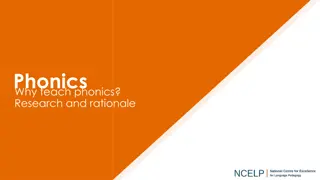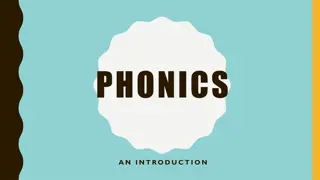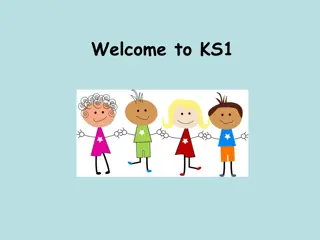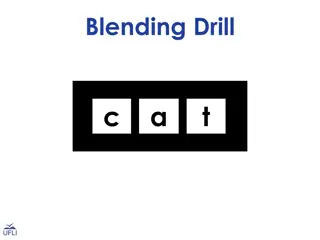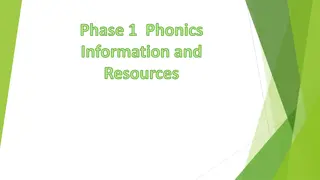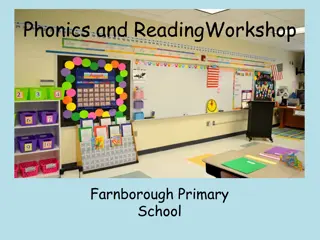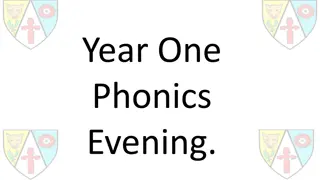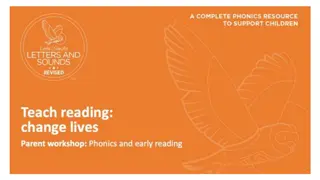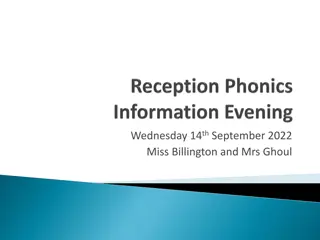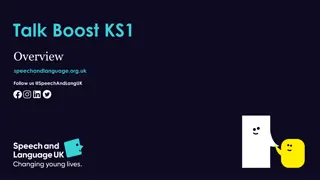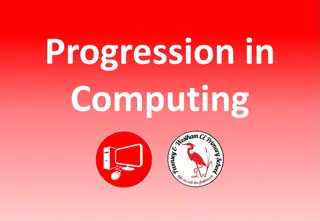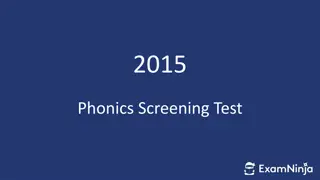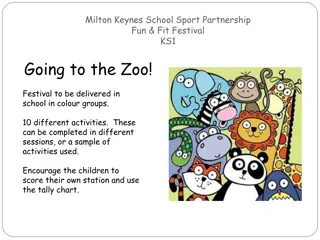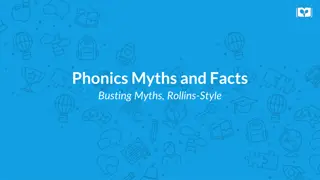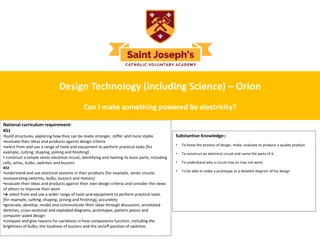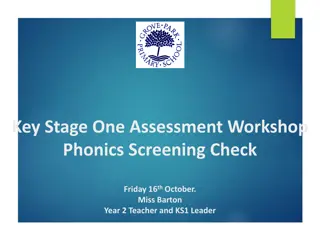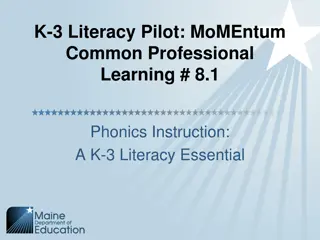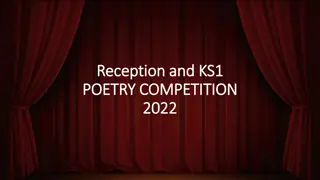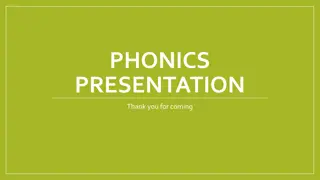Understanding Phonics in KS1: A Comprehensive Overview
Explore the world of phonics in the context of KS1 education, covering essential concepts like phonemes, graphemes, blending, segmenting, and more. Discover how phonics instruction helps children develop crucial reading and spelling skills, complementing other literacy strategies to foster a love of reading among young learners.
Download Presentation

Please find below an Image/Link to download the presentation.
The content on the website is provided AS IS for your information and personal use only. It may not be sold, licensed, or shared on other websites without obtaining consent from the author. Download presentation by click this link. If you encounter any issues during the download, it is possible that the publisher has removed the file from their server.
E N D
Presentation Transcript
KS1 Phonics Workshop Phonics and the Phonics Screening Check
Jargon Buster: Phoneme - a unit of sound Grapheme how a sound is written. Digraph two letters that make one sound. Trigraph three letters that make one sound. Nonsense word a word that has no meaning, a random grouping of graphemes. GPCs the correspondence of a phoneme and the way it can be written (grapheme). Blending reading a word by merging the phonemes together. Segmenting stating the phonemes in a word in order to encode it (spell it/write it). Decode reading a word. Encode spelling a word. Phonics phase - the level in which a child is working. Phonics phases start at phase 1 in the EYFS and progresses through to phase 6 by the end of Year 1/start of Year 2.
What is phonics? There has been a huge shift in the past few years in how we teach reading in UK schools. This is having a positive impact on helping many children learn to read and spell. Phonics is recommended as the first strategy that children should be taught in helping them learn to read. It runs alongside other teaching methods such as Guided Reading and Shared Reading to help children develop all the other vital reading skills and hopefully give them a real love of reading.
So, what exactly is phonics? Words are made up from small units of sound called phonemes. Phonics teaches children to be able to listen carefully and identify the phonemes that make up each word. This helps children to learn to read words and to spell words. In phonics children are taught three main skills
GPCs Children are taught GPCs. This stands for grapheme phoneme correspondences. This simply means that they are taught all the phonemes in the English language and the different ways of writing them. These sounds are taught in a particular order.
Blending Children are taught to be able to blend. This is when children say the sounds that make up a word and are able to merge the sounds together until they can hear what the word is. This skill is vital in learning to read.
Segmenting Children are also taught to segment. This is the opposite of blending. Children are able to say a word and then break it up into the phonemes that make it up. This skill is vital in being able to spell words.
Sound buttons We use sound buttons to help identify the different sounds in a word. For single letter graphemes we use a dot. For digraphs and trigraphs we use a line. For split vowel digraphs we use a bridge line .
The Phonics Screening Check Every year during the Summer term, children in Year 1 sit the phonics screening check. This requires them to read 40 words accurately using their knowledge of phonics. There are 20 real words and 20 nonsense words. The children must decode each word and read it correctly. There is no written element to the phonics screening.
The pass mark for the screening check has historically been 32/40 although this is subject to change. Due to the Covid-19 school closure, the children in Year 2 did not sit the phonics screening check in Summer 2020 and so they are required to sit the check in November 2020. Children in Year 1 will sit the check around June 2021 as they would usually.
What does the Phonics Screening look like? https://www.youtube.com/watch?v=wiJW5qZzlhc Click on the link above to watch a short video clip about the Phonics Screening Check.
Supporting your child at home To support your child with their learning at home it is important that you have some understanding of phonics yourself. However, like most adults you probably didn t do phonics at school. To aid your understanding of GPCs, as well as the information on the previous slides, the Year 2 children have created a video to demonstrate the main GPCs likely to be found in the Phonics Screening, as well as the actions we use to help us remember each one! These can be applied to support your child with home reading and Phonics Screening Check preparation, as well as any other reading and writing that takes place at home.
GPCs and actions https://www.youtube.com/watch?v=IYJKXXBJiAU Click on the link above to watch the Year 2 children demonstrate saying some of the most common GPCs and the actions we use to help remember them.
Alternative GPCs For many phonemes (sounds) there are a variety of graphemes (ways of writing it). e.g. ai there are 8 graphemes for this phoneme: ai, ay, ei, eigh, a_e, aigh, ey, a For all graphemes and alternative graphemes visit the link below. You can also hear the correct pronunciation and examples of words for each. https://cdn.oxfordowl.co.uk/2016/05/05/20/22/32/561/20097_content/index.html?i d=ae#
Split Vowel Digraphs Split vowel digraphs are one of the more difficult graphemes to spot in a word as the 2 letters that make the sound are separated by a consonant. The split vowel digraphs are: a_e (bake, shake, made, trade, spade, tale, whale) e_e (concrete, gene, scene, theme, complete) i_e (ice, bike, mice, spice, tide, polite) o_e (rode, explode, drone, cone, bone, globe) u_e (cube, rude, intrude, confuse, flute)
Useful websites: https://cdn.oxfordowl.co.uk/2016/05/05/20/22/32/561/20097_content/inde x.html?id=ae# http://www.phonicsplay.co.uk/ http://www.teachyourmonstertoread.com


